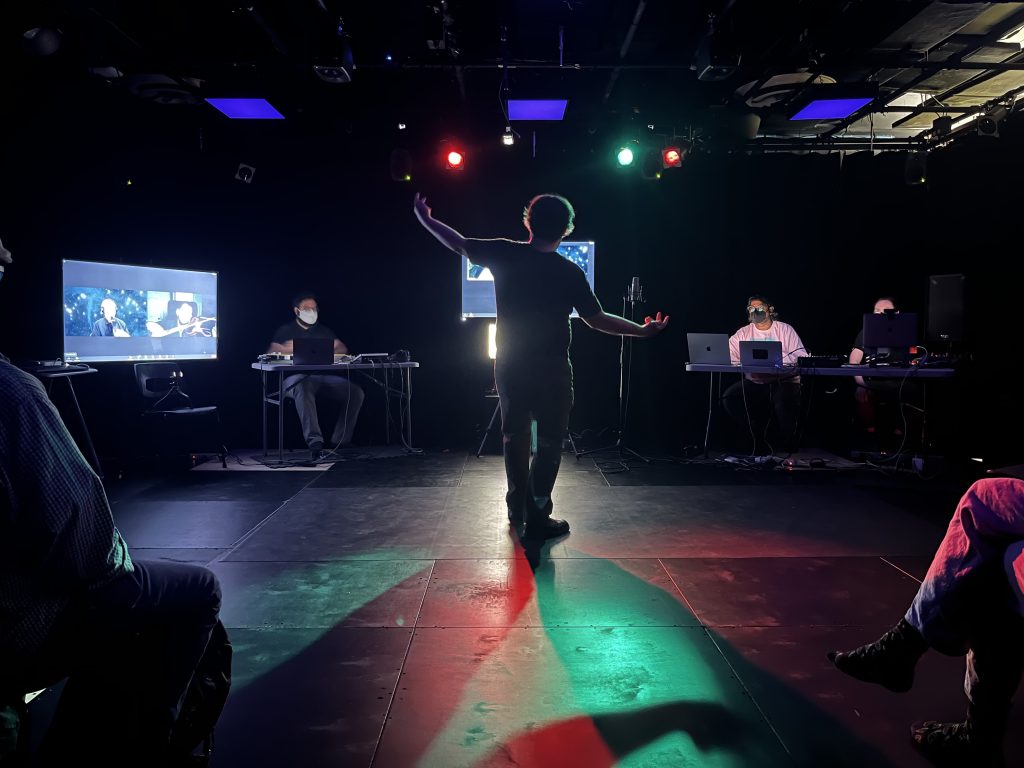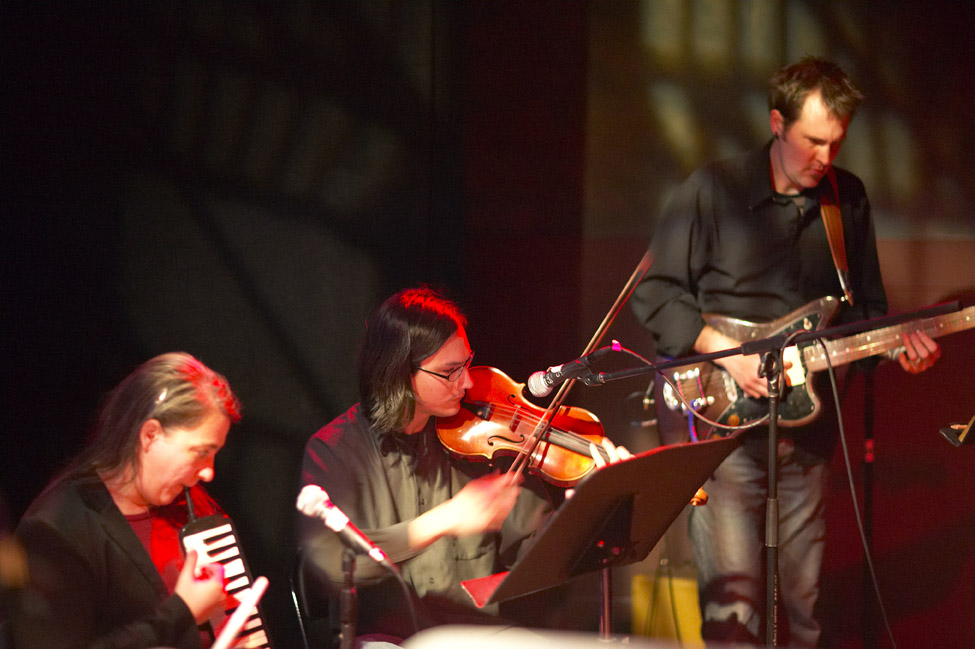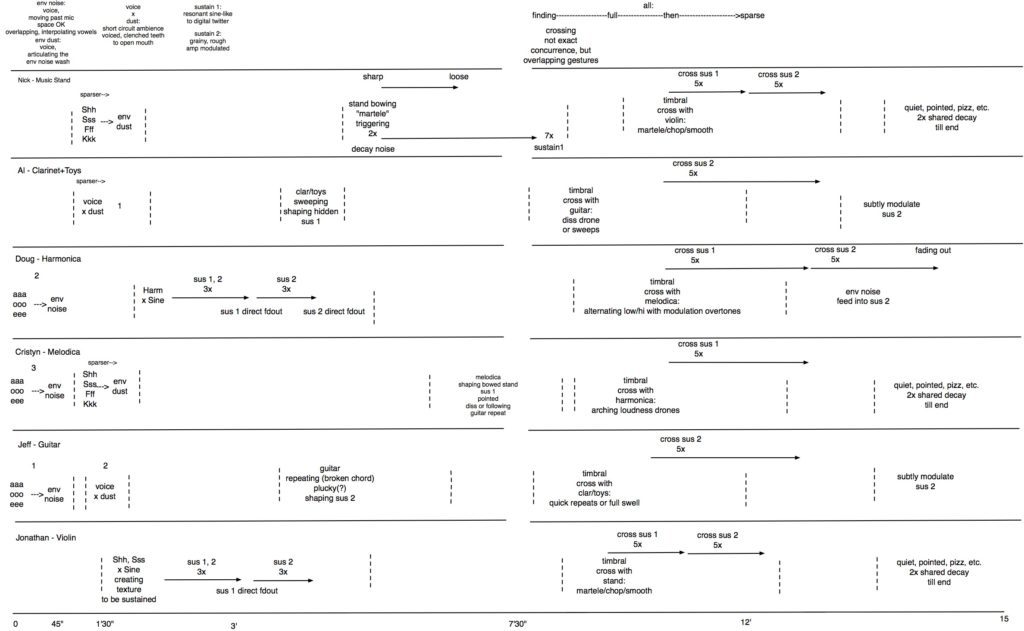A series of two pieces combining text/graphic scores and a custom gestural language, for large-scale ensemble in the telematic medium, created to mark my 20 year anniversary of telematic musicking.
The Original Program Notes for Dispersionology #1:
In the world of physics, dispersion describes a phenomenon in which the rate of propagation of a wave in a medium, its phase velocity, is dependent on its frequency. This can be seen in light, sound, gravity waves, etc. Its a property of telecommunications signals, including the pulses of light in optical fibre cables, describing how the signal broadens and spreads out as it moves across the channel. Dispersion therefore is inherent in the medium that more-and-more binds us these days, in the movements of light pulses that transports our attention, and our listening, around the globe. A beautiful consequence of dispersion is a change in the angle of refraction of different frequencies, leading to a prismatic opening up of a full colour spectrum from incoming light. This ability to broaden out as signals propagate through the network reflects a much wider expansion of distributed listening and sounding that is made possible in the context of telematic musicking. It occurred to me recently that, as of early 2023 I’ve engaged this medium now for 20 years, with an ear towards exploring the myriad ways that the shared real/virtual and nowhere/everywhere site of performance can act as both a point of convergence towards a singular locus of performative attention — yet also a dispersive prism, reflecting individual voices and the preservation of creative agencies of every performer.
I call this current exploration of this phenomenom, at this current milestone moment, “Dispersionology”…. I’ve invited a wide array of past telematic collaborators (spanning this entire 20 years) to explore this and other related tales with me on May 10th. I hope you can join us!
-Doug Van Nort
The concert for piece #1 took place on May 10th as Dispersionology and Other Tales with the following program:
Tuning Meditation
Composer: Pauline Oliveros
Performers: All Sites
Dispersionology
Composer: Doug Van Nort
Performers: All Sites
Other Tales: Algorithmic-chance-structured improvisation
Composer: Doug Van Nort
Performers: All Sites
Performers:
Dispersed/Various Locations:
Chris Anderson-Lundy, Saxophone, Toronto, ON
Tom Bickley, EWI + Max processing, Berkeley, CA
Anne Bourne, cello, Toronto, ON
Cássia Carrascoza Bomfim, flute, Brazil
Chris Chafe, celletto, CCRMA/Palo Alto, CA
Viv Corringham, voice, electronics, New York, NY
Bjorn Eriksson, analog electronics (feedback boxes), Solleftjea, Sweden
Colin James Gibson, guitar, Toronto, ON
Bill Gilliam, piano + electronics, Toronto, ON
Scot Gresham-Lancaster, electronics, Maine
Theodore Haber, violin, Montreal, QC
Glen Hall, Soprano saxophone, contrabass clarinet, Brampton, ON
Holland Hopson, banjo, Tuscaloosa, AL
Rory Hoy, bass + electronics, Brampton, ON
Kai Kubota-Enright, piano (+/- preparation), electronics, Montreal, QC
Al Margolis, violin/contact mic(s)/objects, Chester, NY
Scott L. Miller, Kyma, Minneapolis, MN
Emma Pope, piano, Montreal, QC
Ambrose Pottie, percussion and electronics, Castleton, ON
Dana Reason, piano/inside piano, Oregon State University, Corvallis, Oregon
Omar Shabbar, guitar + electronics, Toronto, ON
Kathy Kennedy, voice + electronics, Montreal, QC
Doug Van Nort, soundpainting, greis/electronics, voice, Toronto, ON
Sarah Weaver, conducting, New York, NY
Zovi, Theremin, Albany, NY
Bogotá (Universidad de Los Andes):
Ricardo Arias, balloons
Leonel Vásquez
(featuring U de Los Andes students)
Chicago (School of the Art Institute of Chicago):
Eric Leonardson, springboard + electronics
Garrett Johnson, electronics
Gordon Fung, electronics
Oslo (Universitetet i Oslo):
Krisin Norderval, voice
Fabian Stordalen, Bass guitar, Guitar, No-input mixing
Kristian Eicke, Guitar (percussive) on lap
Nino Jakeli, Vocals, Guitar, Keyboard
Aysima Baba, Accordion
Alexander Wastnidge, Guitars, Live Electronics
Emin Memis, Ney Flute, Drums
The immersive multi-channel performance – placing the performers at distinct points in the Dispersion Lab space – was recorded with a Zylia 6DOF ambisonic microphone array and is being prepared for future release as a virtual/immersive realization of the piece.
The premiere for piece #2 in this series took place in November 2023 as part of the 2023 NowNet Arts Conference/Festival.










Credits:
Composition and Direction:
Doug Van Nort
Performers – Dispersed/Various Locations:
Chris Anderson-Lundy, Saxophone, Toronto, ON
Tom Bickley, EWI + Max processing, Berkeley, CA
Anne Bourne, cello, Toronto, ON
Cássia Carrascoza Bomfim, flute, Brazil
Chris Chafe, celletto, CCRMA/Palo Alto, CA
Viv Corringham, voice, electronics, New York, NY
Bjorn Eriksson, analog electronics (feedback boxes), Solleftjea, Sweden
Colin James Gibson, guitar, Toronto, ON
Bill Gilliam, piano + electronics, Toronto, ON
Scot Gresham-Lancaster, electronics, Maine
Theodore Haber, violin, Montreal, QC
Glen Hall, Soprano saxophone, contrabass clarinet, Brampton, ON
Holland Hopson, banjo, Tuscaloosa, AL
Rory Hoy, bass + electronics, Brampton, ON
Kai Kubota-Enright, piano (+/- preparation), electronics, Montreal, QC
Al Margolis, violin/contact mic(s)/objects, Chester, NY
Scott L. Miller, Kyma, Minneapolis, MN
Emma Pope, piano, Montreal, QC
Ambrose Pottie, percussion and electronics, Castleton, ON
Dana Reason, piano/inside piano, Oregon State University, Corvallis, Oregon
Omar Shabbar, guitar + electronics, Toronto, ON
Kathy Kennedy, voice + electronics, Montreal, QC
Doug Van Nort, soundpainting, greis/electronics, voice, Toronto, ON
Zovi, Theremin, Albany, NY
Performers – Performance Nodes:
Chicago (School of the Art Institute of Chicago):
Eric Leonardson, springboard + electronics
Garrett Johnson, electronics
Gordon Fung, electronics
Oslo (Universitetet i Oslo):
Krisin Norderval, voice
Fabian Stordalen, Bass guitar, Guitar, No-input mixing
Kristian Eicke, Guitar (percussive) on lap
Nino Jakeli, Vocals, Guitar, Keyboard
Aysima Baba, Accordion
Alexander Wastnidge, Guitars, Live Electronics
Emin Memis, Ney Flute, Drums
Also Broadcasting from Chicago on Free Radio SAIC
In-person audience at Universitetet i Oslo (IMV Salen)
thee Doug Van Nort Electro-Acoustic Orchestra is an ensemble comprised of a mixture of acoustic and electronic performers. It is an emergent sonic organism that evolves through collective attention to all facets of sound, software instruments and text/graphic pieces created by Van Nort, and gesture-based real-time composition in combination with a growing repertoire of these pre-composed structures that are fluidly traversed and integrated spontaneously during performance. The gestural-compositional conducting language used with the group draws upon Van Nort’s experience in electroacoustic improvisation and its unique approach to sound sculpting, shared signal manipulation, the distinct relationships to time/memory/causality that electronics afford, and works that integrate improvisation with pre-composed structures or generative systems. The language is built upon Soundpainting, with many modifications and additions for this project.
This ensemble builds upon the larger Electro-Acoustic Orchestra project, as a more professional and established group which has now had a fixed membership over a longer time scale. This ensemble emerged from the pandemic, integrating select long-term members coming out of the course-based version of the EAO ensemble, with members of the international community of electro/acoustic improvisers (and notably, collaborators from the international Deep Listening community), via telematic connections. The ensemble meets regularly to work through new materials, gestures-concepts and pieces.
The course-based EAO often acts as a pathway to join the professional ensemble for students and professional performer alike. The professional DVN-EAO ensemble has converged to a much higher degree of refinement and specificity, with Van Nort able to compose more involved sonic structures (both electronics as well as text/graphic scores) that are rehearsed and can be called upon and nonlinearly combined in performance, as well as much more “two-way mind reading” that happens in the moment.
thee DVN-EAO regularly performs online and in-person (typically with mixed in-person/telematic performers), and invites proposals for venues and festival performances.
Upcoming and select recent performances include:
November 2023: Ongaku no tomo hall, Tokyo, Japan
December 2022: online/streaming performance for the Winter Solstice
October 2022: keynote performance for the exhibition/symposium Sensoria: The Arts and Science of Our Senses with audiences in Gdansk, Poland and at the Dispersion Lab, featuring immersive haptic/light piece by Van Nort.
May 2022: Elka Bong (Walter Wright and Al Margolis) and thee Doug Van Nort Electro-Acoustic Orchestra in first in-person concert at the Dispersion Lab since the pandemic.
December 2021: Works for the Winter Soltice – online/streaming concert.
June 2021: nO(t)pera Summer Soltice Selections – online/streaming concert.
December 2020: Quarantine: A Telematic nO(t)pera, large scale piece online/streaming concert with audience participation.











Credits:
Composition and Direction:
Doug Van Nort
thee Doug Van Nort Electro-Acoustic Orchestra:
Chris Anderson-Lundy (saxophone), Tom Bickley (EWI+electronics), Viv Corringham (voice+electronics ), Björn Eriksson (feedback boxes), Rory Hoy (bass+electronics), Kathy Kennedy (voice+electronics), Omar Shabbar (guitar+electronics), Danny Sheahan (violin+electronics), Doug Van Nort (soundpainting/composing/electronics).
Booking:
dispersion[dot]relation[at]gmail[dot]com
Quarantine: A Telematic nO(t)pera is a piece by Doug Van Nort, created for the Electro-Acoustic Orchestra (EAO), for the virtual space of connected isolation, for Casper the cat, and for self-sanity. It is not an Opera, but it is not not an Opera. It is a composition for musical, visual and virtual engagement. The music consists of six movements that span disparate sonic landscapes. It is organized by pre-composed palettes that integrate text, graphics, Soundpainting and software instruments, and are augmented with additional real-time composition via EAO’s unique Soundpainting conducting. This content is a crystallization of ideas that have emerged from months of regular online rehearsals that date back to the beginning of the pandemic, bringing together performers from three continents and numerous time zones. As a meditation on (and a product of) our network-mediated present, the nO(t)pera also introduces diverse networks of improvised collaboration: cross performer-machine collaboration, performer-animal collaboration and audience-machine-performer collaboration.
In one movement of the piece, the audience is invited to improvise drawing input that are interpreted by machine learning algorithms, and in turn will determine the overall structure and sonic content of the music.














Credits:
Composition and Direction:
Doug Van Nort
Electro-Acoustic Orchestra:
Tom Bickley (EWI+electronics), Lo Bil (voice), Viv Corringham (voice+electronics ), Björn Eriksson (feedback boxes), Faadhi Fauzi (synths), Colin James Gibson (guitar), Yuanfen Gu (notpera granular patch), Rory Hoy (bass+electronics), Melanie Jagmohan (guitar+legos), Kathy Kennedy (voice+electronics), Aida Khorsandi (notpera FM patch), Nicholas Lina (bass), Kieran Maraj (kin/electronics), Diane Roblin (inside piano/synths), Omar Shabbar (guitar+electronics), Danny Sheahan (violin+electronics), Peter Vukosavljevic (percussion), Doug Van Nort (conducting/composing).
Live action-or-lack-thereof:
Casper, the cat
Cat-herding and video work:
Stacy Denton
Virtual Staging and visuals:
Rory Hoy
Deep Machine Learning (conducting and drawing recognition):
Kieran Maraj
This piece was commissioned by New Adventures in Sound Art (NAISA) for their 2017 Deep Wireless Festival. It was written for the Electro-Acoustic Orchestra with featured violinist Mia Zabelka, and centres around processes and concepts of tuning, fission and fusion.
The concert event, co-produced by Dispersion Lab, NAISA, and Thomas Gerwin at the Exploratorium in Berlin under the theme of “tele-conduction”.





Credits:
Composition:
Doug Van Nort
Performers:
DisPerSion Lab: Dave Bandi, Chris Cerpnjak, Erin Corbett, Ian Jarvis, Ian Macchiusi, Mackenzie Perrault, Fae Sirois, Doug Van Nort, Lauren Wilson
Other Concert Participants:
Berlin: Ivo Berg (recorder), Jenny Doell (dance), Reinhard Gagel (accordion, piano, Mini-Moog),
Thomas Gerwin (banjo, objects, electronics.), Dietrich Petzold (violin, viola)
Compositions: Doug Van Nort, Thomas Gerwin, Sarah Weaver and Glen Hall
Audio Broadcast: NAISA radio
Paralleling my series of Genetic Orchestra pieces, I created two ensemble pieces for acoustic instruments and electronics. The idea was that each sonic gesture is a meme that enters into a system and whose general gestural character evolves over generations, “cross-breeding” with the sounds of fellow performers.
Memetic Orchestra #1 was written for Triple Point and an early version of the FILTER system. It was premiered at the New York City Electroacoustic Music Festival in April 2009. The work explores the use of timbral/textural analysis, gesture recognition and evolutionary algorithms. The sound qualities of the sax and accordion are analyzed and the ‘sonic gestures’ are recognized on the fly by an artificial ‘agent’ who then steers a genetic algorithm, influencing Van Nort’s software performance system. Therefore, acoustic performers influence an agent, who in turn influences the software system that is being performed by a laptop performer who influences the listening of the agent and all are influenced by the overall sound output.
In the first few minutes of this piece the agent controls the sound processing with minor human tuning, and then over the final 7-8 minutes the laptop performer first plays in concert with the agent before taking over to play the GREIS system as well as the evolutionary process itself.
While the piece does explore complex systems and some heavy algorithms (the power of two laptops were needed to run all software), at its heart it is really about listening for all three performers – to the electronic/acoustic balance, to the role of the agent, to the intentions past and present, to the evolutionary trajectory, and so on.
Memetic Orchestra #2 was written for an ensemble of instruments and cross-synthesis algorithms. It was invited for a performance at the Flea Theatre’s “Music with a View” series in November 2009. An exploration in textural transformation and timbral sustain, the piece extracts audio qualities from each player to provide a form within which players articulate subtle inflections, their timbres merging to form a sometimes sparse, sometimes dense collage of each sound’s internal matter.

Graphic/Timeline Component of Score for Memetic Orchestra #2:

Performers for this premiere included:
Van Nort, harmonica
NF Chase, Bowed Music Stand
Jonathan Chen, Violin
Cristyn Magnus, Melodica
Al Margolis, Clarinet and Toys
Jefferson Pitcher, Electric Guitar
This piece for sound walk, recorded objects and chance operations appeared in the original Deep Listening Anthology compilation. It is the result of a chance visit to Murray St. in Montreal at the invitation of Andrew Culver. The piece requires a 30 minute sound walk having different modes of sound observation, for multiple participants.



